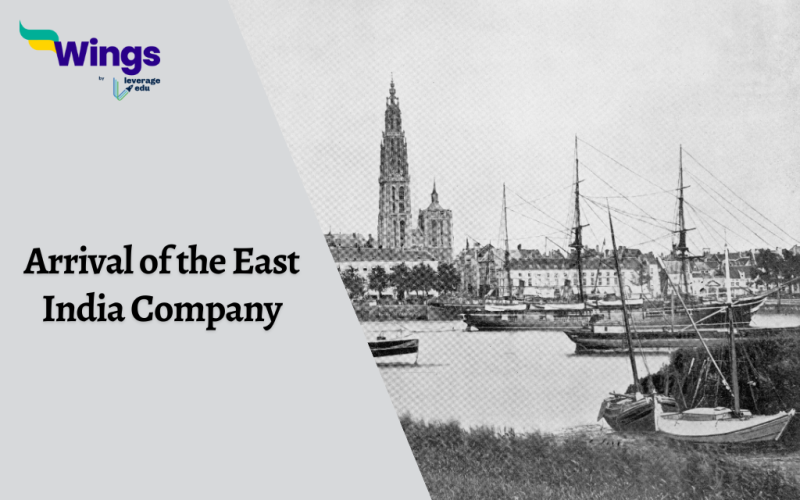On the 31st of December 1600, a joint-stock company was established namely, the British East India Company. A royal charter from Queen Elizabeth I authorised exclusive rights of exclusive trading to the Company, formally named Governor and Company of Merchants of London trading into the East Indies. Initially, a monopoly of 15 years was granted to the East India Company, which in May 1909, was extended indefinitely by a fresh charter.
Also Read: From Trade to Territory – The Company Establishes Power
Table of Contents [show]
Why did the East India Company Arrive in India?
The Company had heard of the profits that the Portuguese had in Eastern trade, the English traders wanted their share too. Since the Dutch were focused more on the East Indies, the English turned to India in search of textiles and other commodities of trade.
How did the East India Company expand in the West and South of India?
- On April 1609, Captain Hawkins arrived at the court of Jahangir, but the mission to establish a factory in Surat did not succeed as the Portuguese opposed it.
- In 1611, the British started trading at Masulipatnam and in 1616, they established a factory.
- In 1612, Captain Thomas Best impressed Jahangir by defeating the Portuguese in the sea off Surat. Then Jahangir granted permission to the English in early 1613 to establish a factory under Thomas Aldworth.
- In 1662, Bombay was gifted to King Charles II by the King of Portugal as dowry Charles married the Portuguese princess Catherine.
- In 1668, the East India Company was given Bombay on an annual payment of 10 pounds only.
- In 1687, the seat of the Western Presidency and the headquarters was shifted from Surat to Bombay.
- There was tacit peace between the Portuguese and the British.
- The English company’s position was improved by the ‘Golden Farman’ issued to them by the Sultan of Golconda in 1632. On payment of 500 pagodas a year, they earned the privilege of trading freely in the ports of Golconda.
- A member of the Masulipatnam council, the British merchant Francis Day in 1639 received from the ruler of Chandragiri permission to build a fortified factory at Madras which later became the Fort St. George and replaced Masulipatnam as the headquarters of the English settlements in south India.
How did the East India Company expand in the East of India?
Bengal was a large and rich province in India, it advanced in trade and commerce. Commercial and political control over Bengal naturally appeared as an attractive proposition to the profit-seeking English merchants. Bengal was also an important province of the Mughal Empire.
In 1651, the Governor of Bengal, Sujauddaula, allowed the East India Company to carry out its trade activities in Bengal. A factory in Hugli was established and three villages, Kolkata, Sutanati, and Govindapur were purchased in 1698 by the Company to build a factory over there. Subsequently, Fort William was raised in order to provide protection around the factory.
Must Read: The Bengal Famine 1770
What was the Royal Farman by Emperor Farrukhsiyar?
In 1715, an English mission led by John Surman to the court of the Mughal emperor Farrukhsiyar secured three famous farmans, giving the Company many valuable privileges in Bengal, Gujarat and Hyderabad. The farmans thus obtained were regarded as the Magna Carta of the Company. Their important terms were:
- In Bengal, the East India Company’s imports and exports were exempted from additional customs duties except for the annual payment of 3,000 rupees as settled earlier.
- The East India Company was permitted to issue dastaks (passes) for the transportation of such goods.
- The Company was permitted to rent more lands around Calcutta.
- In Hyderabad, the Company retained its existing privilege of freedom from duties in trade and had to pay the prevailing rent only for Madras.
- In Surat, for an annual payment of 10,000 rupees, the East India Company was exempted from the levy of all duties.
- It was decreed that the coins of the Company minted at Bombay were to have currency throughout the Mughal Empire.
Apparently, the English East India Company managed to earn a number of trading concessions in Bengal from the Mughal authority by means of flattery and diplomacy.
QUIZ
Results
#1. In which year did the East India Company arrive in India?
#2. Who issued the Royal Farman?
#3. In which Indian city did the East India Company first set up a factory?
Relevant Blogs
| Lord Lansdowne | Lord Irwin |
| Lord Lytton | Lord Chelmsford |
| The Government of India Act 1919 | Civil Disobedience Movement |
| Morley-Minto Reforms | Gandhi Irwin Pact (1931) |
| Bengal Partition | Chalukya Dynasty |
We hope you liked what you read. If you want to read more articles like this you can visit our general knowledge page on Indian History!
 One app for all your study abroad needs
One app for all your study abroad needs


















 45,000+ students trusted us with their dreams. Take the first step today!
45,000+ students trusted us with their dreams. Take the first step today!
